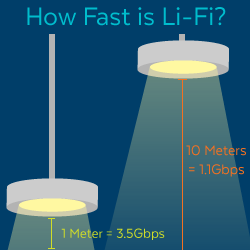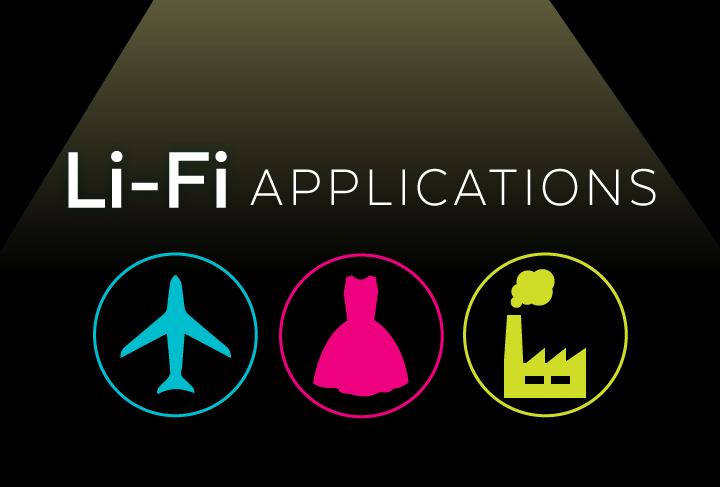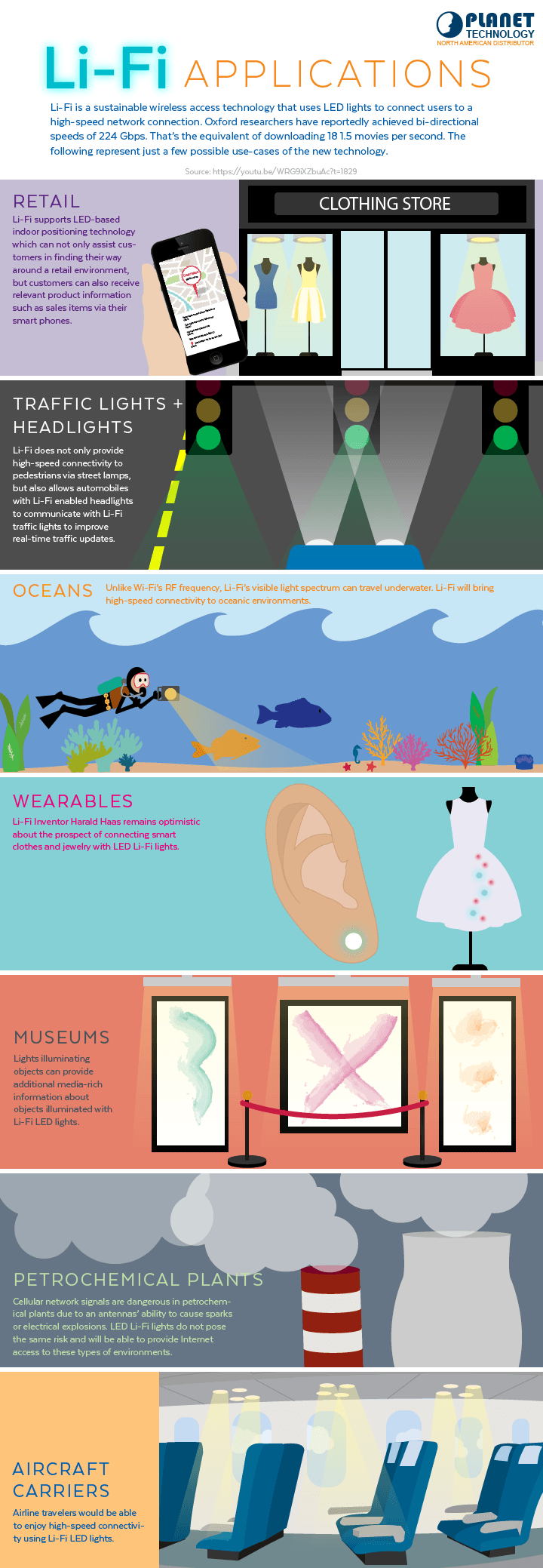Can you imagine downloading 18 1.5 Gb movies in a second, without using Wi-Fi or fiber? Technically, you can, in the laboratory environment of the University of Oxford. Researchers used Li-Fi, an LED-based wireless access technology to achieve bi-directional speeds that are even faster than fiber. Li-Fi is a technology that uses LED lights to provide high-speed Internet connectivity. The relatively new access technology is an energy-efficient alternative to cellular mobile networks.
How does Li-Fi work?
Li-Fi, short for light fidelity, is a Visible Light Communications (VLC) system that relies on the visible light spectrum to provide wireless Internet connectivity. Li-Fi can operate using off-the-shelf LED lights that are connected to transceiver access points. The LED lights transfer binary bits and bytes of data by intermittently flashing lights on and off. They’re essentially strobe lights, but at a rate of 15 million times per second, the rapid flickering remains invisible to the human eye. The LED lights operate as transceivers and transmit data to mobile client devices that rely on a Li-Fi receiver that demodulates the signal to read data. However, because it is a bi-directional technology, the receiver can also act as a transceiver.
 Better Reception in Indoor Enterprise Environments
Better Reception in Indoor Enterprise Environments
How often have you attempted to access the Internet in an indoor enterprise environment only to find yourself staring at a screen with an incessant buffering symbol? Enterprise and retail locations such as restaurants, movie theaters, parking garages, or hospitals oftentimes provide spotty cellular reception due to the infrastructure barriers such as walls and ceilings. Li-Fi provides connectivity to users located directly below or across a light source providing an alternative means of connectivity in these types of environments. Li-Fi provides high-speed connectivity in environments where Wi-Fi is not optimal.
But what happens when Light Fidelity users are moving around from Li-Fi station to Li-Fi station? Li-Fi supports multi-point connections allowing a Li-Fi user to move across an area with many Li-Fi light fixtures without experiencing service interruptions. In similar fashion to wireless roaming, a mobile client device’s Internet session will get handed over to the nearest station without terminating it.
Li-Fi Use-Cases
In his University of Edinburgh speech, Professor Harald Haas highlights a number of Li-Fi use-cases that showcases the benefits of Li-Fi LED lights. For example, Li-Fi enabled street lights could not only provide wireless connectivity to pedestrians but could also communicate with Li-Fi based headlights in cars to provide real-time traffic updates. Another exciting feature, already put to the test by Phillips, is giving users access to indoor navigation in retail environments. Retail environments oftentimes provide poor cellular mobile connectivity due to infrastructure barriers such as walls and ceilings. With this, users can access indoor navigation with each access point they encounter feeding real-time positioning data to their smartphones.
Li-Fi technology can also enter environments where it is unsafe for Wi-Fi to operate. RF frequency, for example, is potentially hazardous in petrochemical plants and petrol stations for example. But because it doesn’t rely on the RF frequency band, wireless connectivity can now be brought into these environments previously deemed unsafe for Wi-Fi.
A Sustainable Alternative to Cellular Base Stations
Using the visible light frequency spectrum instead of the RF frequency provides a sustainable alternative to achieve high-speed wireless connectivity. Professor Harald Hass explains that many base stations, especially in developing countries, still rely on diesel fuel. As a result, base stations are a major contributor of the total mobile power consumption. TechRadar reports that “base stations account for almost 60% of total mobile network power consumption while 20% is consumed by mobile switching equipment and around 15% by the core infrastructure.” But the new technology will not replace traditional RF-based technologies entirely and will instead, work alongside it to mitigate energy consumption.
PoE Could Further Simplify Li-Fi Installation
Li-Fi’s technology could be taken a step further with Power over Ethernet. Power over Ethernet (PoE) is no longer reserved for networking applications. PoE cabling has been successfully used to power large-scale LED lighting installations in enterprise settings. Clemson University recently installed the first large-scale LED lighting deployment fully powered by Power over Ethernet (PoE). With the ability to transmit power and data via a single networking cable, PoE eliminates the expense of installing additional electrical circuitry. If network installers can rely on PoE to deploy LED lighting, and Li-Fi can rely on existing LED lights to transmit Li-Fi, PoE can easily be used to power Li-Fi. The Next Web notes that Redwood Systems is integrating PoE into their Light Fidelity systems stating “In the future, some light fixtures will only have one connector, which works via technology known as power over Ethernet.” PoE’s current high-powered 802.3at system (which yields 30 watts of power) can easily support the low wattage levels that LED lights require.
Market Forecasts for Li-Fi
But just how large exactly is the market? Global Market Insights recently released a report predicting the Li-Fi market will reach USD 9 Billion by 2023. It can support both enterprise networks and mobile wireless networks and provide a partial energy-efficient solution to the high energy power consumption of base stations. There are a number of consortiums arising to support the development of the new technology, as well as a number of companies interested in commercializing their research findings.
One of its major advantages is that the “visible light spectrum is unlicensed, plentiful, and free of charge, [and] thus… can effectively address [the] RF spectrum crunch effect”. The RF spectrum crunch effect is more popularly known as the wireless spectrum crunch. The phenomenon describes the perception that there exists a limited amount of wireless frequency available to support the growing number of wireless devices. Professor Hass believes that the “available radio spectrum will run out by 2020” and utilizing the light spectrum can help alleviate the crowded wireless spectrum.
Just how fast is Li-Fi?

Common Li-Fi Misconceptions
There are a few common misconceptions associated with Li-Fi. Even though it relies on light to transmit data, it is not necessarily a line of sight technology. Light possesses a reflective property allowing light to bounce off white surfaces and can act as an indirect light source. This allows users to gain Li-Fi connectivity even if they are not located directly within the line of sight of a Li-Fi access station. Another misconception associated with it is that lights cannot be dimmed. Though dimming lights will decrease bandwidth, dim lights can still transmit at high-speed rates. Professor Haas was able to obtain 1 Gbps with 5mW of LED light.
Heightened Security
Li-Fi also has the added benefit of offering more secure connectivity in comparison to Wi-Fi. In order for hackers to snoop a wireless Li-Fi connection, they’d have to remain within the visible vicinity of a user and utilize the same access point. Unlike Wi-Fi, hackers will no longer be able to initiate snooping attacks from the privacy of another room. The Internet of Things revolution will introduce a number of consumer and industrial smart devices that will contain sensitive information. With a wireless technology like Light Fidelity, these devices can experience another level of security not currently possible with Wi-Fi.
Related Posts:
- How PoE is Revolutionizing LED Lights in Smart Homes and Offices
- Home Sweet Smart Home – 7 Must Have Smart Home Devices
- Why The New 802.11ah Wi-Fi Standard Will Give Z-Wave a Run for Its Money

 Better Reception in Indoor Enterprise Environments
Better Reception in Indoor Enterprise Environments

